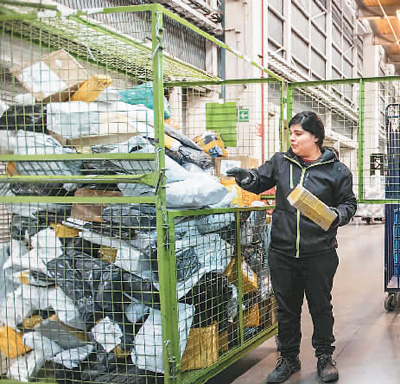

Cross-border e-commerce in China has created new growth in the country's foreign trade and facilitated trade, finance and people-to-people connectivity.
Shopping in the global market
Thanks to cross-border e-commerce platforms, shrimp produced in Ecuador can now be delivered to a dinner table in Beijing within a number of hours. So too can Chilean cherries, Mexican avocados as well as a variety of other foreign foods.

Consumers shop at an exhibition center of imported commodities transported to Zhengzhou via China-Europe freight trains. Photo from Xinhua News Agency
Besides food, these platforms have also made Sri Lanka's Ceylon black tea, Nepalese bodhi bracelets, Egyptian cotton products, Czech crystal and Burmese jade accessible to consumers.
According to statistics, products from 50 countries along the Belt and Road have been introduced to China via JD.com, one of China’s biggest e-commerce platforms, and Chinese products are now being continuously sold to 54 countries along the route via JD.
According to statistics from Alibaba, consumers from 225 countries and regions created a total of 812 million orders during the online shopping spree on Nov. 11 last year.
New channels, new platforms
Cross-border e-commerce not only provides Chinese small and medium enterprises (SMEs) with convenient platforms to go global, but also brings infinite possibilities to countries along the Belt and Road.

Photo shows Chinese and foreign businessmen at the China International E-commerce Expo 2018.
China’s cross-border e-commerce is expected to serve 2 billion consumers worldwide by 2020, according to Xing Yue, vice president of Alibaba.
Xing said China’s cross-border e-commerce is an important support in global trading and Chinese enterprises have been helping countries along the Belt and Road build logistics and create inclusive finance.
In the past, it took 60 days between placing an order and receiving products in Russia, but now, as big data is used on the customs declaration system, the checking process takes much less time.
“If you go to Russia, Spain or the Netherlands, ask a few people in the local area, one in two people knows AliExpress.com,” said Shen Difan, former general manager of AliExpress, the global sales platform of Alibaba. AliExpress reached 100 million overseas customers as of April 2017.
New trading mode attracts worldwide attention
“Many countries along the Belt and Road have shown great interest in learning from China’s experience in developing e-commerce,” Shen said.

An employee sorts parcels from China at a postal logistics center in Santiago, capital of Chile. Photo from Xinhua News Agency
On June 1, 2018, delegates of overseas Chinese media from over 20 countries arrived at the JD headquarters, hoping to learn from China’s experience in e-commerce.
Kee Lim, a coffee retailer in Papua New Guinea, was so excited to learn that she could sell her coffee to consumers across the globe without having to share the profits with distributors.
“Countries along the Belt and Road can set out on their own journey on the basis of China’s e-commerce experience without having to start from scratch. That reflects China’s spirit of cooperation and the target of mutually beneficial outcomes”, says Wang Shutong, CEO of DHgate.com, a cross-border e-commerce site.
The e-commerce site has participated in a program to help SMEs in Turkey, Azerbaijan and Georgia establish their own e-commerce platforms.
 Fire brigade in Shanghai holds group wedding
Fire brigade in Shanghai holds group wedding Tourists enjoy ice sculptures in Datan Town, north China
Tourists enjoy ice sculptures in Datan Town, north China Sunset scenery of Dayan Pagoda in Xi'an
Sunset scenery of Dayan Pagoda in Xi'an Tourists have fun at scenic spot in Nanlong Town, NW China
Tourists have fun at scenic spot in Nanlong Town, NW China Harbin attracts tourists by making best use of ice in winter
Harbin attracts tourists by making best use of ice in winter In pics: FIS Alpine Ski Women's World Cup Slalom
In pics: FIS Alpine Ski Women's World Cup Slalom Black-necked cranes rest at reservoir in Lhunzhub County, Lhasa
Black-necked cranes rest at reservoir in Lhunzhub County, Lhasa China's FAST telescope will be available to foreign scientists in April
China's FAST telescope will be available to foreign scientists in April "She power" plays indispensable role in poverty alleviation
"She power" plays indispensable role in poverty alleviation Top 10 world news events of People's Daily in 2020
Top 10 world news events of People's Daily in 2020 Top 10 China news events of People's Daily in 2020
Top 10 China news events of People's Daily in 2020 Top 10 media buzzwords of 2020
Top 10 media buzzwords of 2020 Year-ender:10 major tourism stories of 2020
Year-ender:10 major tourism stories of 2020 No interference in Venezuelan issues
No interference in Venezuelan issues
 Biz prepares for trade spat
Biz prepares for trade spat
 Broadcasting Continent
Broadcasting Continent Australia wins Chinese CEOs as US loses
Australia wins Chinese CEOs as US loses